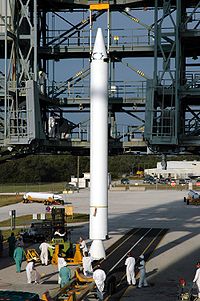GEM 46

A GEM-40 is hoisted for attachment to a Delta II
|
|
| Manufacturer | Alliant Techsystems |
|---|---|
| Country of origin | United States |
| Used on | Delta II, Delta III, Delta IV |
| Launch history | |
| Status | Active |
| GEM-40 | |
| Length | 11.4 m (449 in) |
| Diameter | 1.0 m (40 in) |
| Gross mass | 13,005 kg (28,671 lb) |
| Propellant mass | 11,767 kg (25,942 lb) |
| Thrust | 499 kN (112,200 lbf) |
| Specific impulse |
245 s (sea level) |
| Burn time | 63 seconds |
| Fuel | HTPB |
| GEM-46 | |
| Length | 12.6 m (495 in) |
| Diameter | 1.2 m (46 in) |
| Gross mass | 19,140 kg (42,196 lb) |
| Propellant mass | 16,860 kg (37,180 lb) |
| Thrust | 601 kN (135,200 lbf) |
| Specific impulse |
242 s (sea level) |
| Burn time | 77 seconds |
| Fuel | HTPB |
| GEM-60 | |
| Length | 13.2 m (518 in) |
| Diameter | 1.5 m (60 in) |
| Gross mass | 33,638 kg (74,158 lb) |
| Propellant mass | 29,697 kg (65,471 lb) |
| Thrust | 879 kN (197,500 lbf) |
| Specific impulse | 245 s (sea level) |
| Burn time | 91 seconds |
| Fuel | HTPB |
245 s (sea level)
242 s (sea level)
A Graphite-Epoxy Motor (GEM) is a solid-fuel rocket motor (SRM) produced by Orbital ATK (Formerly Alliant Techsystems) with an epoxy composite casing. GEM boosters have been used on the Delta II, Delta III, and Delta IV, and are planned for future use on the Atlas V and Vulcan.
On August 5, 1995, an air-lit GEM-40 failed to separate from a Delta II 7925 carrying Koreasat I. The excess mass of the booster resulted in the satellite reaching a lower than intended transfer orbit, which it was able to compensate for using on-board propellant.
On January 17, 1997, a Delta II (Delta 241) exploded due to a catastrophic failure in a GEM-40. The failure triggered the launch vehicle's self-destruct function 13 seconds after ignition. An Air Force investigation determined that the motor's casing had been damaged prior to launch, resulting in the casing splitting open soon after ignition.
...
Wikipedia
